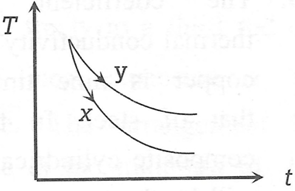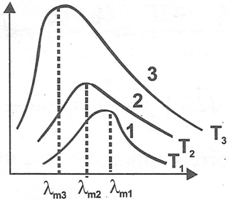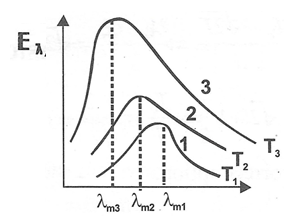12th Grade > Physics
HEAT TRANSFER MCQs
Total Questions : 30
| Page 1 of 3 pages
Question 1. A spherical ball A of surface area 20 cm2 is kept at the centre of a hollow spherical shell B of area 80 cm2. The surface of A and the inner surface of B emit as blackbodies. Assume that the thermal conductivity of the material of B is extremely poor and that of A is very high and that the air between A and B has been pumped out. The heat capacities of A and B are 42 J/∘C and 82 J/ ∘ C respectively. Initially the temperature of A is 100 ∘ C and that of B is 20 ∘ C.Find the rate of change of temperature of A and that of B at this instant.
Answer: Option D. -> 0.03∘c/s and 0.01∘c/s
:
D
The inner surface of B radiates at a rate of ΔQΔt=σABT4A,
where σ→ stefan's constant
AB →Area
TB → Temperature
Similarly, A radiates ΔQ2Δt=σABT4A
Now, all the radiation from inner surface of B goes inside the hollow of the shell, as B is a very poor conductor. So, this radiation falls on A, and A being a blackbody absorbs all the radiation falling on it! And it being a good conductor the heat travels to the centre almost instantly, thus making the temperature uniform throughout the ball. Similarly, all the heat radiated by A is completely absorbed by inner surface of B, and none of it is lost to the surrounding as B is a very poor conductor.
∴ Net heat lost by B = Net heat gained by A =σ(ABT4B−AAT4A)
= 5.67×10−8×(80×293.1s4−20×373.1s4)×10−4
= 1.15 w
Now this is equal to specific heat ×dtemperaturedTime of both A and B
∴dTAdt=1.1542∘c/s=0.03∘c/s
dTBdt=1.1582∘c/s=0.01∘c/s
:
D
The inner surface of B radiates at a rate of ΔQΔt=σABT4A,
where σ→ stefan's constant
AB →Area
TB → Temperature
Similarly, A radiates ΔQ2Δt=σABT4A
Now, all the radiation from inner surface of B goes inside the hollow of the shell, as B is a very poor conductor. So, this radiation falls on A, and A being a blackbody absorbs all the radiation falling on it! And it being a good conductor the heat travels to the centre almost instantly, thus making the temperature uniform throughout the ball. Similarly, all the heat radiated by A is completely absorbed by inner surface of B, and none of it is lost to the surrounding as B is a very poor conductor.
∴ Net heat lost by B = Net heat gained by A =σ(ABT4B−AAT4A)
= 5.67×10−8×(80×293.1s4−20×373.1s4)×10−4
= 1.15 w
Now this is equal to specific heat ×dtemperaturedTime of both A and B
∴dTAdt=1.1542∘c/s=0.03∘c/s
dTBdt=1.1582∘c/s=0.01∘c/s
Answer: Option B. -> 6.1 min
:
B
As the temperature differences are small, we can use Newton's law of cooling.
dθdt=−k(θ−θ0)dθθ−θ0=−kdt ...(i)
Where k is a constant,θ is the temperature of the body at time t and θ0 = 16∘C is the temperature of the surrounding. We have,
∫360c400cdθθ−θ0=−k(5min)In360c−160c400c−160c=−k(5min)
or,k=−In(5/6)5min
or,If t be the time required for the temperature to fall from 360C to 320C then by (i),
∫320c360cdθθ−θ0=−ktIn320c−16c360c−160=−In(5/6)t5mint=In(4/5)In(5/6)×5min=6.1min
:
B
As the temperature differences are small, we can use Newton's law of cooling.
dθdt=−k(θ−θ0)dθθ−θ0=−kdt ...(i)
Where k is a constant,θ is the temperature of the body at time t and θ0 = 16∘C is the temperature of the surrounding. We have,
∫360c400cdθθ−θ0=−k(5min)In360c−160c400c−160c=−k(5min)
or,k=−In(5/6)5min
or,If t be the time required for the temperature to fall from 360C to 320C then by (i),
∫320c360cdθθ−θ0=−ktIn320c−16c360c−160=−In(5/6)t5mint=In(4/5)In(5/6)×5min=6.1min
Question 3. The graph shown in the adjacent diagram, represents the variation of temperature (T) of two bodies, x and y having same surface area, with time (t) due to the emission of radiation. Find the correct relation between the emissivity (e) and absorptivity (a) power of the two bodies. (IIT JEE 2003)

Answer: Option A. -> ex>ey,ax>ay
:
A
From the graph it is clear that initially both the bodies are at same temperature but after that at any instant temperature of body x is less than the temperature of body y. It means body x emits more heat i.e., emissivity of body x is more than body y ∴ex>ey and according to Kirchhoff's law good emitter are also good absorber so ax>ay.
:
A
From the graph it is clear that initially both the bodies are at same temperature but after that at any instant temperature of body x is less than the temperature of body y. It means body x emits more heat i.e., emissivity of body x is more than body y ∴ex>ey and according to Kirchhoff's law good emitter are also good absorber so ax>ay.
Question 4. A cylindrical rod with one end in a steam chamber and the other end in ice results in melting of 0.1gm of ice per second. If the rod is replaced by another with half the length and double the radius of the first and if the thermal conductivity of material of second rod is 14 that of first, the rate at which ice melts in gm/sec will be
Answer: Option C. -> 0.2
:
C
Qt=KAΔθl⇒mLt=K(πr2)Δθl
⇒ Rate of melting of ice (mt)∝Kr2l
Since for second rod K becomes14th r becomes double and length becomes half, so rate of melting will
be twice i.e. (mt)2=2(mt)1=2×0.1=0.2gm/sec.
:
C
Qt=KAΔθl⇒mLt=K(πr2)Δθl
⇒ Rate of melting of ice (mt)∝Kr2l
Since for second rod K becomes14th r becomes double and length becomes half, so rate of melting will
be twice i.e. (mt)2=2(mt)1=2×0.1=0.2gm/sec.
Answer: Option C. -> (π6)13:1
:
C
Q=σAt(T4−T40)
If T,T0,σ and t are same for both bodies then QsphereQcube=AsphereAcube=4πr26a2 .....(i)
But according to problem, volume of sphere = Volume of cube ⇒43πr3=a3⇒a=(43π)13r
Substituting the value of a in equation (i) we get
QsphereQcube=4πr26a2=4πr26{(43π)13r}2
=4πr26(43π)23r2=(π6)13:1
:
C
Q=σAt(T4−T40)
If T,T0,σ and t are same for both bodies then QsphereQcube=AsphereAcube=4πr26a2 .....(i)
But according to problem, volume of sphere = Volume of cube ⇒43πr3=a3⇒a=(43π)13r
Substituting the value of a in equation (i) we get
QsphereQcube=4πr26a2=4πr26{(43π)13r}2
=4πr26(43π)23r2=(π6)13:1
Question 6. Polyurethane is quite good for cold weather for jackets and blankets. However, thermal emergency blankets or space blankets are often made up of something similar to aluminum foil and used by astronauts to avoid hypothermia when stuck in subzero temperature. Why do you think it is a good choice?
Answer: Option A. -> Thermal blankets reflect the body heat back, thereby trapping it inside
:
A
'Aluminum foil like' thermal blankets are designed to reflect most of the radiation, or infrared radiation.
Also, they are shiny! This makes them easy to spot from helicopters etc, in case of rescue operations.
So, all in all, a must have for campers!
:
A
'Aluminum foil like' thermal blankets are designed to reflect most of the radiation, or infrared radiation.
Also, they are shiny! This makes them easy to spot from helicopters etc, in case of rescue operations.
So, all in all, a must have for campers!
Answer: Option B. -> 5800 K
:
B
Let the diameter of the sun be D and its distance from the earth be R. From the question,
DR≈0.53×π180
=9.25×10−3 . ...(i)
The radiation emitted by the surface fo the sun per unit time is
At distance R, this radiation falls on an area 4πR2 in unit time. The radiation received at the earth's surface per unit time per unit area is, therefore,
:
B
Let the diameter of the sun be D and its distance from the earth be R. From the question,
DR≈0.53×π180
=9.25×10−3 . ...(i)
The radiation emitted by the surface fo the sun per unit time is
At distance R, this radiation falls on an area 4πR2 in unit time. The radiation received at the earth's surface per unit time per unit area is, therefore,
Answer: Option B. -> 4000 K
:
B
Area under curve represents the emissive power of the body
ETE2000=ATA2000=161 (given) ...(i)
But from Stefan's law E α T4
∴ETE2000=(T2000)4 ...(ii)
From (i) and (ii) (T2000)4=161
⇒T2000=2⇒T=4000k.
:
B
Area under curve represents the emissive power of the body
ETE2000=ATA2000=161 (given) ...(i)
But from Stefan's law E α T4
∴ETE2000=(T2000)4 ...(ii)
From (i) and (ii) (T2000)4=161
⇒T2000=2⇒T=4000k.
Question 9. Penguins huddling: To withstand the harsh weather of the Antarctic, emperor penguins huddle in groups. Assume that a penguin is a circular cylinder with a top surface area a =0.26 m2 and height h = 90 cm. Let Pr be the rate at which an individual penguin radiates energy to the environment (through the top and the sides); thus NPr is the rate at which N identical, well-separated penguins radiate. If the penguins huddle closely to form a huddled cylinder with top surface area Na and height h, the cylinder radiates at the rate Ph. If N = 1000, by what percentage does huddling reduce the total radiation loss?
Answer: Option D. -> 27%
:
D
Heat loss by individula penguin =σeApenguin(T4penguin−T4environment)
=σe(2πrpenguinh+2πr2penguin)(T4penguin−T4environment)
Let, σe(T4penguin−T4environment)=k
∴Heatlostby1000penguinsradiatingfarawayfromeachother,Q1
=1000(2πrpenguinh+2πr2penguin)k
Now, πr2penguin=0.26m2orrpenguin=0.287m
Also, πr2huddle=Napenguin=1000×0.26orrhuddle=9.09m
∴Heat lost by hudle of [enguins,Q2
=σeAhuddle(T4penguin−T4environment)=(2pirhuddleh+2πr2huddle)k
NOw, percentage of reduce in radiation loss is given by Q2Q1=(2pirhuddleh+2πr2huddle)×100/
N(2pirpenguinh+2πr2huddle)=26.67%
:
D
Heat loss by individula penguin =σeApenguin(T4penguin−T4environment)
=σe(2πrpenguinh+2πr2penguin)(T4penguin−T4environment)
Let, σe(T4penguin−T4environment)=k
∴Heatlostby1000penguinsradiatingfarawayfromeachother,Q1
=1000(2πrpenguinh+2πr2penguin)k
Now, πr2penguin=0.26m2orrpenguin=0.287m
Also, πr2huddle=Napenguin=1000×0.26orrhuddle=9.09m
∴Heat lost by hudle of [enguins,Q2
=σeAhuddle(T4penguin−T4environment)=(2pirhuddleh+2πr2huddle)k
NOw, percentage of reduce in radiation loss is given by Q2Q1=(2pirhuddleh+2πr2huddle)×100/
N(2pirpenguinh+2πr2huddle)=26.67%
Answer: Option A. -> Sun - T3, tungsten filament - T1, welding are - T2
:
A
According to Wein's displacement law λm×T = Constant
Here λm<λm2<λm1 ⇒T3>T2>T1

The temperature of Sun is higher than that of welding arc which in turn is greater than tungsten filament.
Therefore T3 is the Sun's temperature, T2 the welding arc's and T1 the tungsten filament's.
:
A
According to Wein's displacement law λm×T = Constant
Here λm<λm2<λm1 ⇒T3>T2>T1
The temperature of Sun is higher than that of welding arc which in turn is greater than tungsten filament.
Therefore T3 is the Sun's temperature, T2 the welding arc's and T1 the tungsten filament's.

















